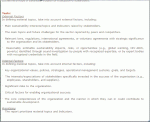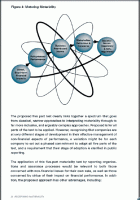Imagine something you can live without; an atlas, perhaps, or pretty wallpaper. These may improve your quality of life or be useful repositories of knowledge, but they’re not strictly necessary for your day to day existence.
Now think of the things you really do need: air, water and nutrients must be top of your list. Additionally, shelter is useful for maintain a good health and transport is normally necessary to continue to earn a living.
Materiality within sustainability reporting is the concept of how much something is part of a business’ ongoing processes. How material it is to that company’s existence.
So taking the example above, pretty wallpaper and an atlas are pretty immaterial to an individual’s existence. Conversely air, water and nutrients are most definitely material, as are transport and shelter to a given degree.
Narrowing the focus
The concept of materiality is essential for large, all embracing standards such as the Global Reporting Initiative (GRI) G3. This is because no one company will ever need to report all the standard’s constituent indicators.
Therefore, a means of deciding which ones to report against is required. That means is materiality, with companies obliged to include indicators for all items which are material to their business.
To assist in determining what is and isn’t material, GRI have included in G3 a small list of tests which can be applied. These include stakeholder concerns are a criterion, as well as local laws, risks and the company’s competencies.
As this may leave the scope too wide, companies may also consider whether a criterion is of “significant impact”, broadly defining that as being anything which requires active management by the company, at any level.
Dividing into boxes
Materiality is similarly important within the Institute of Social and Ethical Accountability’s AA1000 series.
Here a five point test is proposed in order to determine whether or not an area is material to a business. Briefly, these tests are:
- does the item have a direct financial impact upon the business; for instance, purchasing electricity from a non-renewable source, and thus making the company subject to paying the Climate Change Levy
- is the item part of a strategic aim or overall policy; for instance, if a company’s policy is to reduce its waste the amount it recycles is considered to be material
- is the item commonly reported by the company’s sector peers; for instance if all paper manufacturers bar one reported the amount of bleach they discharge, then this indicator would be considered material for that one
- is the item a matter of concern for stakeholders; for instance, the growing concern in fashion about ethically sourced clothing has forced many retailers to make statements concerning their supply chains
- is the item considered part of the norms of the environment within which the company is operating; for instance greenhouse gas emissions, which is unlikely to ever be directly regulated but whose reporting is starting to become standard across a variety of sectors
The Materiality of Materiality
At all times, it must be remembered that the general definition of materiality within audit circles is based upon the impression created by the report under consideration.
If by excluding an item the report creates a false or misleading impression, then that item is held to be material to the business and should have been in the report.
It’s also worth remembering that a false or misleading impression can be either better or worse than the actuality. Companies therefore need to be careful they neither exaggerate nor underrate their performance.
This is particularly important now that the Companies Act (2006) has made sustainability reporting part of the legislative framework, and reporting professionals expect this area of regulation to be strengthened as time goes by.
Under the rules of the Financial Services Authority (FSA) firms can be delisted for failing to submit full and proper reports in a timely manner. As many sustainability professionals expect the Companies Act to be strengthened, companies should start to determine what is material to measuring their sustainability before the regulatory environment starts to harden against them.
A former CTO, Chris has a broad and varied background. He’s been involved with blue chips, consultancies & SMEs across a wide variety of sectors and has worked in Europe, the Middle East and Australia.
In 2007 he decided to combine his knowledge of business and IT with his passion for all things sustainable and has been busy writing ever since. However, his greatest ambition remains to brew the perfect cup of coffee.





Please do you have a sample materiality test you can share with me? I need to do one ungently and would like to see a typical example as a guide. Many thanks.